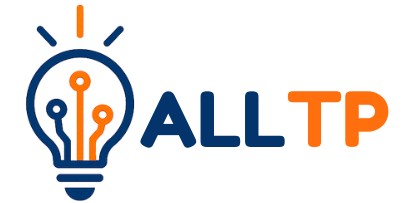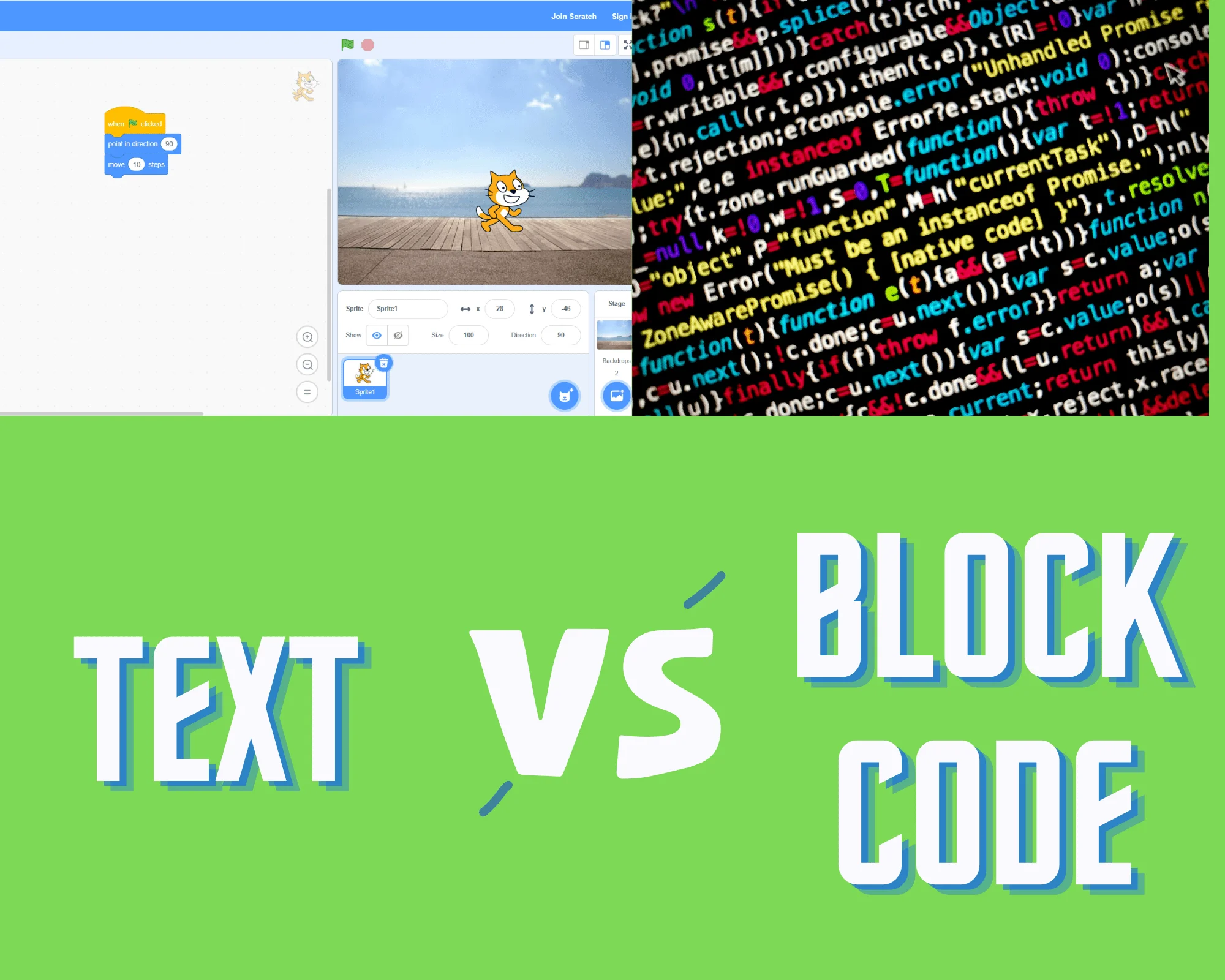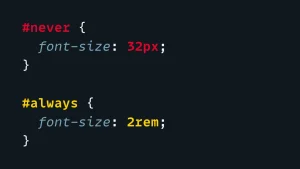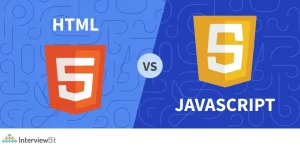In today’s fast-paced digital world, coding has become a foundational skill, just like reading or math. It’s not just about preparing kids for tech careers; learning to code strengthens critical thinking, creativity, and problem-solving skills that are valuable in every aspect of life.
When introducing children to coding, there are two main approaches: block coding and text coding. Block coding uses colorful, drag-and-drop blocks to represent code, making it ideal for beginners. Text coding, on the other hand, involves writing actual code using programming languages like Python or JavaScript.
This article will help you understand the key differences between these two methods and guide you in choosing the best starting point for your child’s coding journey. If you’re ready to take the first step, enroll your child in our coding bootcamp, a fun and structured way to introduce coding for kids through both block and text programming.
What is Block Coding?
1.1 Definition and Overview
Block coding is a form of visual programming where users create code by dragging and dropping pre-made blocks that represent different programming commands. Instead of typing complex syntax, children snap these blocks together like puzzle pieces to build interactive stories, games, and animations.
This method is widely used in beginner-friendly platforms such as Scratch, Code.org, and Tynker, which make coding accessible and fun for young learners.
1.2 Pros of Block Coding
- Beginner-Friendly and Intuitive: The visual, colorful interface makes it easy for children to understand coding logic without getting overwhelmed by technical details.
- Reduces Syntax Frustration: Kids don’t have to worry about spelling mistakes or punctuation errors, allowing them to focus on the logic and structure of their programs.
- Encourages Creativity: Block coding platforms are designed to let kids bring their ideas to life through animations, music, games, and storytelling projects.
1.3 Cons of Block Coding
- Limited Flexibility for Advanced Concepts: While block coding is great for basics, it can’t easily handle more complex programming tasks like databases, APIs, or advanced algorithms.
- Can Become Repetitive Over Time: As children grow in their skills, they may find block coding less challenging or engaging.
- Not Common in Professional Settings: Block coding serves as a stepping stone, but real-world programming relies on text-based languages, which block coding doesn’t fully prepare kids for on its own.
What is Text Coding?
2.1 Definition and Overview
Text coding involves writing lines of code using actual programming languages such as Python, JavaScript, HTML, and others. Unlike block coding, there are no visual aids, kids type instructions directly into a text editor, using correct syntax, punctuation, and structure to make their programs run.
Text coding is the format used by professional developers and is the foundation of real-world software, websites, and applications. As coding Kenya continues to grow, introducing children to text coding ensures they’re aligned with global and local industry standards, preparing them to participate meaningfully in the country’s expanding digital economy.
2.2 Pros of Text Coding
- More Powerful and Flexible: Text-based languages can do much more than block coding platforms, allowing kids to build complex apps, games, websites, and even artificial intelligence projects.
- Reflects Real-World Programming Environments: Since professional developers use text coding, learning it prepares children for future tech careers and more advanced computer science education.
- Builds Problem-Solving and Typing Skills: Text coding requires kids to think critically, troubleshoot issues, and become comfortable with a keyboard, essential skills in today’s digital world.
2.3 Cons of Text Coding
- Higher Learning Curve: Text coding can be more difficult to start with, especially for younger children or those with no prior experience.
- Syntax Errors Can Discourage Beginners: A single misplaced letter or missing character can break the code, which may frustrate kids who are still learning.
- Requires Stronger Reading and Keyboarding Skills: Because kids must read, type, and follow instructions precisely, they need a higher level of literacy and typing fluency than is required for block coding.
Comparing Block vs Text Coding
Choosing between block and text coding depends on your child’s age, interest, and learning style. Here’s a side-by-side comparison to help you see the key differences at a glance:
| Feature | Block Coding | Text Coding |
| Ease of Use | Very beginner-friendly | Requires more effort and attention to detail |
| Creativity | Great for storytelling, games, and animations | Better for logic-heavy and technical projects |
| Error Handling | Few syntax issues; easy to troubleshoot | Frequent syntax errors; more debugging required |
| Real-world Usage | Introductory only | Reflects professional, real-world programming |
| Age Suitability | Ideal for ages 5–10 or early beginners | Best for ages 10+ or those with some coding experience |
This comparison shows that both methods have their place. Block coding is perfect for getting started, while text coding builds on that foundation with more depth and real-world relevance.
How to Choose What’s Best for Your Child
Every child is different, and choosing between block coding and text coding isn’t about which is better, it’s about which is better for your child. To make the best choice, consider these three key factors:
Consider Age and Developmental Stage
One of the most important things to consider is your child’s age and cognitive development.
- Ages 5–9: At this stage, children are still developing fine motor skills, reading fluency, and abstract thinking. Block coding is ideal here because it removes the complexity of syntax and allows them to learn programming logic through fun, visual interaction. Platforms like Scratch Jr or Code.org use vibrant colors and characters to hold their attention and make learning feel like play.
- Ages 10+ or Teens: As children grow, they develop stronger reading, typing, and problem-solving abilities. This is the perfect time to introduce or transition them to text coding, where they begin to type actual code in languages like Python or JavaScript. Teens especially benefit from learning how real-world applications work, which builds confidence and prepares them for more serious tech exploration.
Tip: Don’t rush the transition; let your child master one level before moving to the next.
Evaluate Interest and Learning Style
Understanding your child’s learning preferences can guide you toward the best approach.
- Visual and creative learners often enjoy block coding because of its interactive, colorful interface. It feels like storytelling or digital art, which is great for kids who enjoy design, animation, or games.
- Logical, detail-oriented, or language-loving learners may be more naturally drawn to text coding. If your child enjoys puzzles, problem-solving, or writing, they might find typing out code more satisfying and rewarding.
Also, consider your child’s patience level. Block coding offers quicker results with less frustration, which can be motivating for younger or easily discouraged learners. Text coding requires more perseverance, but the sense of achievement after solving a bug is often greater. Research from Harvard’s Graduate School of Education ScratchEd project shows how block-based environments reduce syntax errors and cognitive overload, helping children build confidence and problem-solving resilience, skills that transfer to text-based coding later on.
Think About Long-Term Goals
Ask yourself (and your child): Why are we learning to code?
- For fun, exploration, and foundational skills, block coding is more than enough. It introduces essential logic, structure, and creativity in a playful environment. Even if your child never becomes a professional programmer, the thinking skills they gain are invaluable.
- For serious tech interest or future careers, it’s essential to plan a gradual transition to text coding. Mastering a language like Python not only prepares them for future academic courses but also opens the door to building real apps, games, websites, and even AI tools.
Remember, it’s not a race. Starting with block coding and transitioning to text coding over time is often the best path, especially for young learners with long-term goals in tech.
Best of Both Worlds
The great news is that you don’t have to choose strictly between block coding or text coding, many platforms now offer hybrid learning environments that allow children to experience both, making the transition smooth and natural.
Start with Blocks, Then Move to Text
Block coding is an excellent way to introduce young learners to the logic and structure of programming without overwhelming them with syntax. As their confidence and curiosity grow, some platforms allow you to toggle between block-based and text-based views, giving kids a glimpse of the actual code behind their projects.
This gradual exposure bridges the gap between simple and advanced programming, helping children realize that the logic they’ve learned in blocks is the same used in real-world coding languages.
Platforms That Support Transitioning
Here are a few popular tools that make this progression possible:
- Scratch + Python: While Scratch itself is block-based, many learners transition to Python afterward because the concepts carry over well. Some educators even use tools like Edublocks, which display both blocks and Python code side by side.
- Microsoft MakeCode: This platform is a favorite for teaching coding with micro:bit, games, and hardware. It allows users to write programs in block form and instantly view or switch to JavaScript or Python.
- Tynker: Tynker offers structured learning paths where children begin with block coding and gradually move to text-based languages as they advance through the levels.
These tools not only promote a smoother transition but also help children make meaningful connections between visual and written code. They see that the logic stays the same, only the way it’s expressed changes.
Why Hybrid Learning Works
Hybrid learning encourages flexibility and confidence. Kids learn at their own pace, gradually building the skills they need to move from visual, intuitive programming to typing code in real languages. This model supports both immediate creativity and long-term growth, making it ideal for children with evolving interests or uncertain goals.
Conclusion
Both block coding and text coding play an important role in a child’s coding journey. Block coding offers a fun, approachable way for young learners to understand the fundamentals of programming without being overwhelmed by complex syntax. It sparks creativity, builds logical thinking, and lays a strong foundation.
Text coding, on the other hand, provides the depth and flexibility needed for more advanced projects. It reflects how real-world programming works and prepares children for future opportunities in technology and beyond.
Enroll your child in our coding bootcamp today and give them the tools to thrive in the digital world. From playful creativity to powerful coding for beginners skills, we’ll help them grow with confidence, one line of code at a time. Let’s build the future, one young coder at a time!




